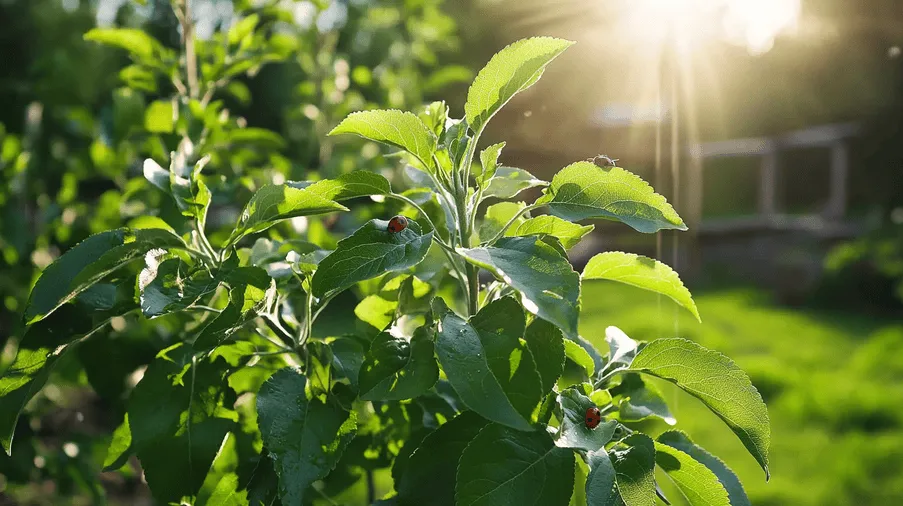Let me be brutally honest. My first fruit tree orchard looked like an all-you-can-eat bug buffet. Aphids. Beetles. Caterpillars. You name it. I watched helplessly as these tiny terrorists destroyed months of hard work. Back then I knew nothing about natural pest control. Everything I tried seemed to fail spectacularly.
My neighbor Robert – an old-school organic gardener with decades of experience – took one look at my devastated trees and said something I’ll never forget: “Nature has solutions. You just need to learn how to work with her instead of against her.”
Those words changed everything about how I approach pest management in my garden.
Understanding the Pest Ecosystem
Bugs aren’t just mindless destroyers. They’re part of a complex ecological system. Some are harmful. Some are actually beneficial. The key is creating balance rather than total elimination.
Most gardeners make a critical mistake. They see a bug and immediately want to nuke the entire garden. But here’s the truth: a healthy garden has insects. The goal isn’t to create a sterile environment but to manage populations and protect your fruit trees.
The Bug Hierarchy in Your Orchard
Not all insects are created equal. Some are predators. Some are pollinators. Some are pure destruction machines. Understanding this hierarchy is crucial to natural pest management.
Beneficial Insects:
- Ladybugs: Nature’s aphid assassins
- Lacewings: Soft-bodied pest hunters
- Predatory wasps: Caterpillar control specialists
- Ground beetles: Soil-level pest managers
Harmful Insects:
- Aphids: Sap-sucking tree destroyers
- Codling moths: Apple and pear fruit attackers
- Spider mites: Leaf-destroying specialists
- Scale insects: Bark and branch parasites
Natural Deterrent Strategies
Companion Planting: Your First Line of Defense
Companion planting isn’t just a trendy gardening concept. It’s a strategic biological warfare technique. Certain plants naturally repel specific insects while attracting beneficial predators.
Powerful Companion Plants:
- Marigolds: Nematode and aphid deterrent
- Garlic: Broad-spectrum pest repellent
- Mint: Ant and rodent control
- Nasturtiums: Trap crop for aphids
- Lavender: Attracts pollinators, repels moths
By strategically planting these around your fruit trees you create a natural defensive perimeter. It’s like building a biological force field that confuses and deters potential pest invaders.
Homemade Organic Pest Sprays
Commercial pesticides are chemical warfare. Organic sprays are like strategic diplomatic negotiations with the insect world.
Essential Organic Spray Recipes:
- Garlic-Pepper Spray
- Blend 4-5 garlic cloves
- Add 2 tablespoons hot pepper
- Mix with water
- Strain and spray Effectiveness: Broad-spectrum pest deterrent
- Neem Oil Solution
- Mix 2 tablespoons neem oil
- Add mild liquid soap
- Dilute in water
- Spray weekly Effectiveness: Disrupts insect breeding cycles
- Soap Spray
- Mix mild liquid soap
- Add water
- Spray directly on insects Effectiveness: Suffocates soft-bodied pests
Encouraging Natural Predators
Your garden needs an army. But instead of buying weapons you’re recruiting soldiers.
Predator Attraction Techniques:
- Install bird houses
- Create water sources
- Leave some areas slightly wild
- Avoid complete garden sterilization
Birds. Frogs. Beneficial insects. These are your unpaid security team.
Soil Health: The Root of Pest Prevention
Healthy trees resist pests better than weak ones. It’s that simple.
Soil management isn’t glamorous. But it’s the foundation of pest resistance. Think of soil like the immune system of your fruit trees.
Soil Health Boosters:
- Regular compost additions
- Proper mulching
- Balanced mineral content
- Avoiding chemical fertilizers
- Promoting beneficial microorganisms
A tree growing in rich living soil is like a human with a strong immune system. It can fight off attackers more effectively.
Physical Barriers and Mechanical Controls
Sometimes you need direct intervention. But do it smartly.
Effective Physical Barriers:
- Sticky traps
- Protective netting
- Copper tape around tree trunks
- Diatomaceous earth
- Reflective mulches
These methods interrupt pest life cycles without massive chemical interventions.
Seasonal Pest Management
Every season brings different challenges.
Spring:
- Monitor emerging insects
- Apply dormant oil sprays
- Prune for air circulation
- Remove winter debris
Summer:
- Regular inspection
- Maintain companion plants
- Use targeted organic sprays
- Monitor moisture levels
Fall:
- Clean up fallen fruit
- Remove diseased branches
- Prepare for overwintering pests
Winter:
- Apply dormant sprays
- Inspect tree structure
- Plan next season’s strategy
When to Seek Professional Help
Some pest infestations require expert intervention. Signs you need help:
- Consistent major damage
- Unknown pest species
- Widespread tree health decline
- Complex multi-species invasion
Final Thoughts: Working With Nature
Protecting fruit trees isn’t about declaring war on insects. It’s about understanding the intricate balance of your garden ecosystem. Every bug. Every plant. Every patch of soil tells a story.
My journey from frustrated novice to somewhat-competent gardener wasn’t linear. It was messy. Filled with destroyed crops and hard-learned lessons. But those failures taught me something crucial: nature doesn’t respond to force. It responds to understanding.
Your fruit trees are more than just producers of delicious harvest. They’re living systems. Complex. Resilient. Interconnected with everything around them. The moment you stop seeing pests as enemies and start seeing them as part of a larger ecological conversation is the moment you become a true gardener.
Some years you’ll lose some battles. Other years you’ll have fruit so abundant you’ll be begging neighbors to take them off your hands. That’s the beautiful unpredictability of working with nature.
Remember this: A perfect orchard isn’t one without a single bug. It’s one where bugs. trees. soil. and gardener exist in a delicate. dynamic balance.
Keep your hands dirty. Your mind open. Your observations sharp.

